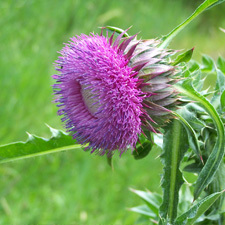
Thistles
Common name: Californian thistle
Botanical name: Cirsium arvense
Common name: Nodding thistle
Botanical name: Carduus nutans
Common name: Scotch thistle
Botanical name: Cirsium vulgare
Management category: Advisory
Originally from Europe and Asia and all naturalised in New Zealand in late nineteenth century.
Why are they a pest?
- Very competitive and overshadow other plants.
- Invade large areas of pasture and are unpalatable to stock and reduce pasture productivity.
- Contaminate wool and can shelter pests such as rabbits.
Where are they found?
- Pasture, alluvial flats, stockyards, sheep camps, roadsides and tracks.
- Invade pasture areas with summer drought and moist mild winters.
- Seed dispersed mostly by wind, also by water, mud, hay, on machinery and animals.
- Very common in the Bay of Plenty.
What do they look like?
Californian thistle
- Perennial with creeping roots and buds that rise up as aerial shoots.
- Slender flower stems up to 1m tall with flower head clusters.
- The purple or mauve (rarely white) flower heads occur in the summer.
- Male and female flower heads occur on separate plants.
- The male flower head is shorter and less urn-shaped than the female, and has no fluffy white pappi which occur in late summer early autumn and act as parachutes for dispersing the seeds from the female flower head.
- Leaves are hairless, or have cobwebby hairs, green above and paler underneath, with shallow notches between triangular spiny lobes.
- Often occurs as distinct patches of either male or female plants.
Nodding thistle
- Leaves are dark green, deeply divided into triangular lobes with spiny tips, and do not have large, distinct white markings, although the leaf margins are white at the base of the marginal spines.
- Flowering stems arise from the often large rosettes have spiny wings except just below the flower heads.
- Flowerheads are usually 2–6cm across, the largest being solitary at the top of the flower stalk that droop or nod when mature. Smaller heads are found on lateral branches.
- Flower petals are red-purple (November to February).
- Seeds have thistle down, soft feathery attachments which help the seeds disperse for short distances.
- Nodding thistles have an annual or biennial life-cycle, living for one or two years.
Scotch thistles:
- Biennial thistle with large reddish, prickly thistle flowers, either one or in clusters of two or three flowers at the tops of the branched stems.
- Leaves are large (up to 30cm long by 10cm across), dark green, divided almost to the midrib, with sharp prickles at the ends of the leaf lobes. Prickly hairs are on the upper surface and white cottony hair on the lower surface.
- Can form a large ‘shrub’ in late summer and has a large tap root.
- Erect branched stems with spiny wings grow to 1.5m tall.
- Flowers (Nov to March) producing reddish-purple flower heads which grow solitary or in clusters of two or three flowers.
- Outer bracts of flower heads are slightly hairy with strong sharp spines up to 4mm long.
- After flowering each seed head contains small, narrow seeds (about 4mm long), each with a feathery thistledown about 20–25mm long.
What are the rules?
Advisory
Council does not enforce the control of advisory species. It is landowner/occupier responsibility to manage these pests. Council may provide advice on how to manage or control advisory species if required.
CAUTION: When using any herbicide or pesticide, PLEASE READ THE LABEL THOROUGHLY to ensure that all instructions and directions for the purchase, use and storage of the product, are followed and adhered to.
Read more on pest control advice, information and regulations.
Images






